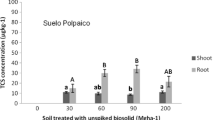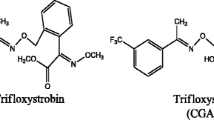Abstract
Putative allelochemicals found in the soil of no-tillage and conventional-tillage wheat plots near Stillwater, Oklahoma, were obtained by a mild alkaline aqueous extraction procedure, bioassayed to determine their biological activity, purified, and analyzed with a capillary gas chromatography-mass spectrometry-data analysis system. The most significant inhibition was found in bioassays of extracts from soil collected immediately after harvest in June, July, and August. No-tillage soils produced significant inhibition during the rest of the year also. Mass spectrometry showed fatty acids as the most abundant compounds. However, when bioassayed authentic samples of the five free fatty acids showed no significant biological activity toward wheat.
Similar content being viewed by others
References
Alsaadawi, J.S., Rice, E.L., andKarns, T.K.B. 1983. Allelopathic effects ofPolygonum aviculare L. III. Isolation, characterization, and biological activities of phytotoxins other than phenols.J. Chem. Ecol. 9:761–774.
Cast, K.G. 1987. Allelochemical interactions in the soil from no-tillage versus conventional-tillage wheat (Triticum aestivum) systems. MS thesis. Oklahoma State University, Stillwater, Oklahoma. 74 pp.
Eight Peak Index of Mass Spectra, 3rd ed. 1983. University of Nottingham, Royal Society of Chemistry, Mass Spectrometry Data Centre, United Kingdom.
Elliott, L.F., andCheng, H.-H. 1987. Assessment of allelopathy among microbes and plants, pp. 504–515,in G.R. Waller, (ed.).Allelochemicals: Role in Agriculture and Forestry. ACS Symposium Series 330. American Chemical Society, Washington, D.C.
Elliott, L.F.,Gilmour, C.M.,Lynch, J.M., andTittemore, D.D. 1984. Bacterial colonization of plant roots.Amer. Soc. Agron. Spec. Pub. No. 47, pp. 1–16. Madison, Wisconsin.
Fuerst, E.P., andPutnam, A.R. 1983. Separating the competitive and allelopathic components of interference: Theoretical principles.J. Chem. Ecol. 9:937–943.
Guenzi, W.D., andMcCalla, T.M. 1962. Inhibition of germination and seedling development by crop residues.Soil Sci. Soc. Am. Proc. 26:456–458.
Kimber, R.W.L. 1973. Phytotoxicity from plant residues III. The relative effect of toxins and nitrogen immobilization on the germination and growth of wheat.Plant Soil 38:543–555.
Lynch, J.M. 1977. Phytotoxicity of acetic acid produced in the anaerobic decomposition of wheat straw.Appl. Bacteriol. 42:81–87.
Lynch, J.M. 1987. Allelopathy involving microorganisms: Case histories from the United Kingdom, pp. 44–52,in G.R. Waller (ed.).Allelochemicals: Role in Agriculture and Forestry. ACS Symposium Series, 330. American Chemical Society, Washington, D.C.
McCalla, T.M., andDuley, F.C. 1949. Stubble mulch studies III. Influence of soil microorganisms and crop residues on the germination, growth, and direction of root growth of corn seedlings.Soil Sci. Soc. Am. Proc. 14:196–199.
McCalla, T.M., andHaskins, F.A. 1964. Phytotoxic substances from soil microorganisms and crop residues.Bacteriol. Rev. 28:181–207.
McGown, S.R., andWaller, G.R. 1986. The LKB-2091 capillary gas chromatograph/mass spectrometer/data analysis system using IBM-PCAT. Abstract of papers, 34th Annual Conference Mass Spectrometry and Applied Topics. Cincinnati, Ohio, June 8–13, pp. 306–307.
Norstadt, F.A., andMcCalla, T.M. 1963. Phytotoxic substance from a species ofPencillium Science 140:410–411.
Oklahoma Department of Agriculture. 1987. Soil County Survey Map, Payne County, Oklahoma, Department of Agriculture, Oklahoma City, Oklahoma.
Putnam, A.R., andTang, C.S. 1986.The Science of Allelopathy. John Wiley & Sons, New York.
Rice, E.L. 1984.Allelopathy, 2nd ed. Academic Press, New York.
Ruehle, P.H.,Browne, C.E., andEisenbraun, E.J. 1979. A convenient large-scale diazomethane generator.Chem. Ind. 225.
Samtsevich, S.A. 1965. Active secretions of piant roots and their significance.Fiziol. Rast. 12:837–846. [Cited by G.C. Head, 1973,Shedding of Roots, pp. 237–293,in T.T. Kozlowski, (ed.).Shedding of Plant Parts. Academic Press, New York.]
Spoehr, H.A., Smith, J.A.C., Strain, H.H., Milner, H.W., andHardin, G.J. 1949. Fatty acid antibacterials from plants (Pub. #586). Carnegie Institute, Washington, D.C.
Stevenson, F.J. 1967. Organic acids in soils, pp. 119–146,in A.D. McLauren and G.H. Petergoy (eds.).Soil Biochemistry, Vol. 1, Marcel Dekker, New York.
Tang, C.S., andWaiss, A.C., Jr., 1978. Short chain fatty acids as growth inhibitors in decomposing wheat straw.J. Chem. Ecol. 4:225–232.
Thompson, A.C., (ed.). 1985.The Chemistry of Allelopathy. (ACS Symposium Series 265). American Chemical Society, Washington, D.C. 470 pp.
Thorne, R.L.Z., Waller, G.R., McPherson, J.K., Krenzer, E.G., Jr., andYoung, C.-C. 1990. Autotoxic effects of old and new wheat straw and conventional-tillage and no-tillage wheat (Triticum aestivum) soil.Bot. Bull. Acad. Sinica 31:35–49.
Wallace, J.M., andElliott, L.E. 1979. Phytotoxins from anaerobically decomposing wheat straw.Soil Biol. Biochem. 11:325–330.
Wallace, J.M., andWhitehand, L.C. 1980. Adverse synergistic effects between acetic, propionic, butyric and valeric acids on the growth of wheat seedling roots.Soil Biol. Biochem. 12:445–446.
Waller, G.R. (ed.) 1972.Biochemical Applications of Mass Spectrometry. John Wiley & Sons, New York.
Waller, G.R. (ed.) 1987.Allelochemicals: Role in Agriculture and Forestry. ACS Symposium Series 330. American Chemical Society, Washington, D.C. 605 pp.
Waller, G.R., andDermer, O.C. (eds.). 1980.Biochemical Applications of Mass Spectrometry, 2nd ed. John Wiley & Sons, New York.
Waller, G.R,Ritchey, C.R.,Krenzer, E.G.,Jr., Smith, G., andHamming, M. 1984. Natural products from soil. Abstracts, 32nd Annual Conference Mass Spectrometry and Allied Topics. San Antonio, Texas, pp. 144–145.
Waller, G.R,Ritchey, C.R.,Krenzer, E.G.,Jr., Smith, G., andHamming, M. 1985. Natural products from soil. Paper presented at the 190th American Chemical Society Meeting, Chicago, Illinois. Abstract No. 110.
Waller, G.R., Krenzer, E.G., Jr., McPherson, J.K., andMcGown, S.R. 1987. Allelopathic compounds in soil from no-tillage vs. conventional-tillage in wheat production.Plant Soil 98:5–15.
Author information
Authors and Affiliations
Additional information
Journal Article No. 5650 of the Oklahoma Agricultural Experiment Station, Oklahoma State University, Stillwater, Oklahoma 74078.
Rights and permissions
About this article
Cite this article
Cast, K.G., Mcpherson, J.K., Pollard, A.J. et al. Allelochemicals in soil from no-tillage versus conventional-tillage wheat (Triticum aestivum) fields. J Chem Ecol 16, 2277–2289 (1990). https://doi.org/10.1007/BF01026937
Received:
Accepted:
Issue Date:
DOI: https://doi.org/10.1007/BF01026937




